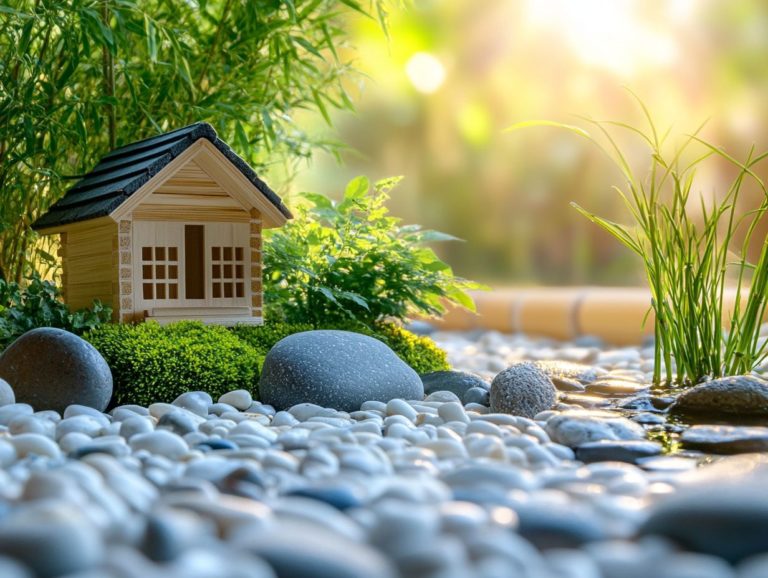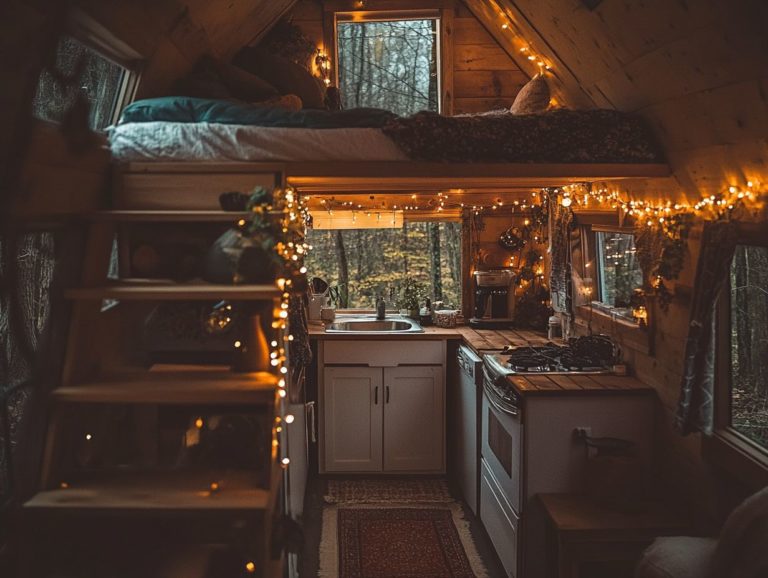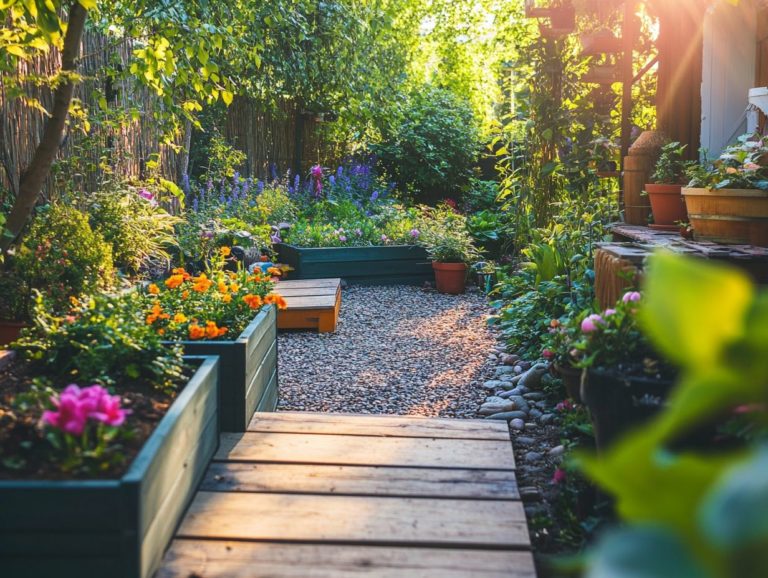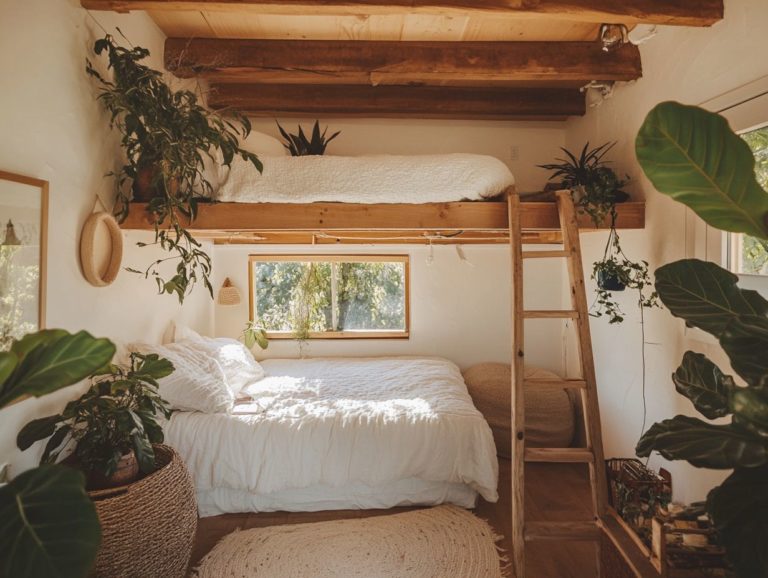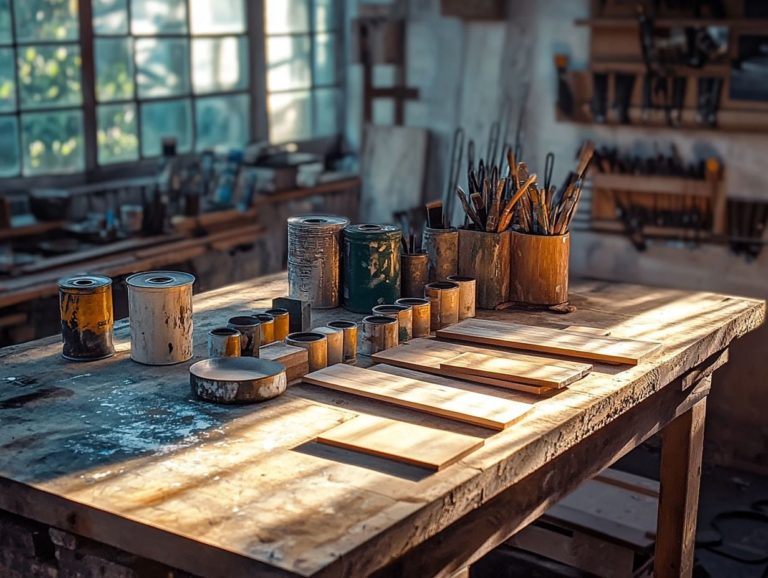5 DIY Tiny House Maintenance Tips
Maintaining a tiny house may seem less intimidating than managing a traditional home, but it still demands your regular attention to keep everything in optimal condition.
From checking for leaks and water damage to ensuring that your plumbing and electrical systems are functioning seamlessly, every detail is crucial.
Let s explore five essential DIY maintenance tips that will help you preserve your cozy haven and steer clear of costly repairs.
This guide also covers how often to perform these tasks, highlights common issues you might encounter, and provides ways to save money while keeping your space in excellent shape.
Dive in to discover how to maximize your tiny living experience!
Contents [hide]
- Key Takeaways:
- 1. Regularly Check for Leaks and Water Damage
- 2. Inspect and Clean Gutters and Downspouts
- 3. Maintain the Roof and Exterior Walls
- 4. Keep the Plumbing and Electrical Systems in Good Condition
- 5. Clean and Declutter Regularly
- How Often Should Tiny House Maintenance Be Done?
- Frequently Asked Questions
- What are 5 DIY Tiny House Maintenance Tips?
- Why is it important to maintain a tiny house?
- Can I perform DIY maintenance on my tiny house?
- When should I schedule maintenance for my tiny house?
- Are there specific maintenance tasks for a tiny house on wheels?
- What should I do if I notice a major issue with my tiny house?
Key Takeaways:
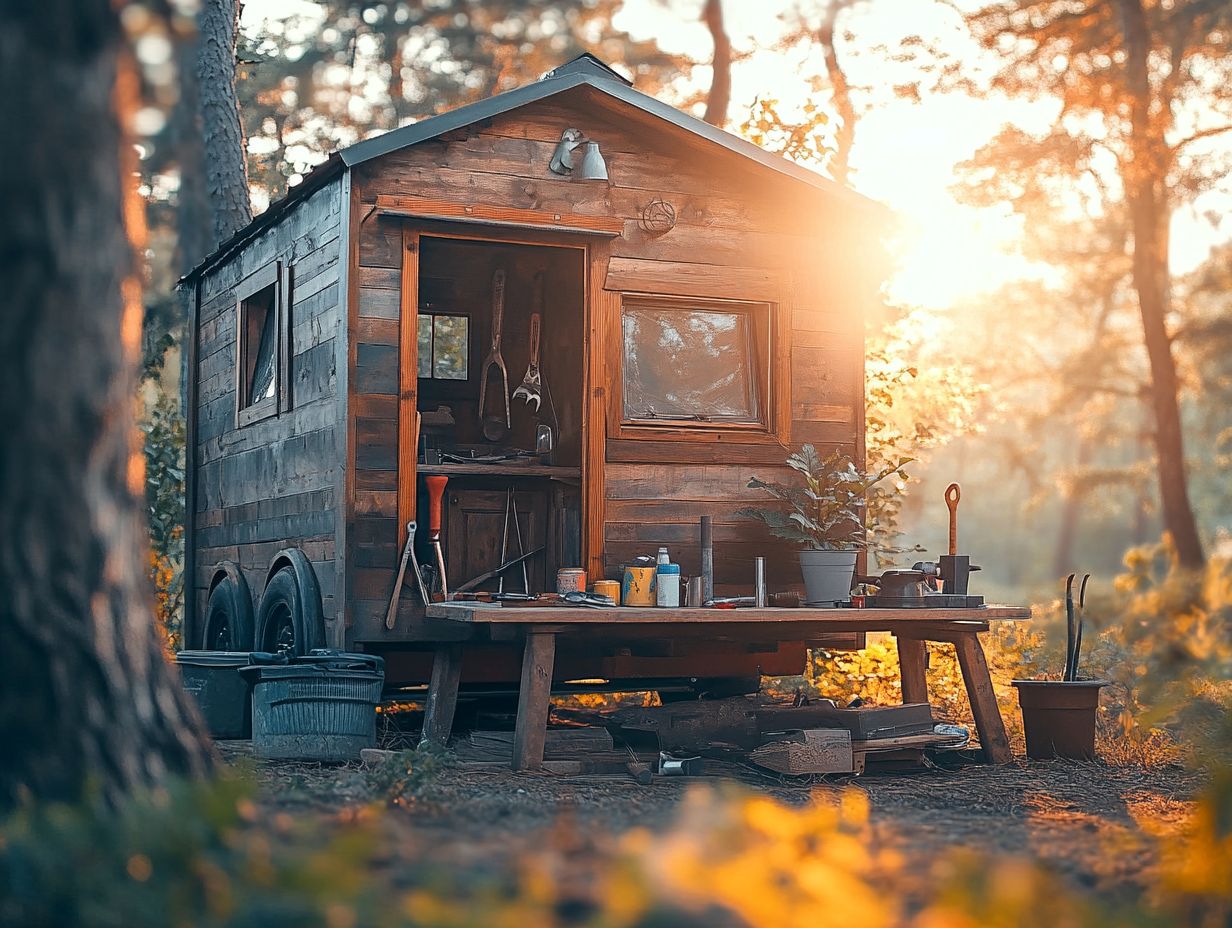
- Regularly check for leaks and water damage to prevent costly repairs.
- Inspect and clean gutters and downspouts to avoid water buildup and damage.
- Keep plumbing and electrical systems in good condition to ensure safety and functionality.
1. Regularly Check for Leaks and Water Damage
In the tiny house movement, it s essential to regularly check for leaks and water damage to maintain the structural integrity of your home. Even minor issues can escalate into significant problems if you let them linger. By conducting frequent plumbing inspections, you can identify potential sources of water damage early, which is crucial for your DIY maintenance and overall home upkeep.
Embracing environmentally friendly features, such as compost toilets and water-efficient plumbing, not only minimizes the risk of water damage but also boosts the energy efficiency of your tiny home.
Assess plumbing connections, like faucets and pipes, as these tend to be wear points over time. Don t overlook the foundation; inspecting it for signs of moisture intrusion is vital, as this can compromise the stability of your structure.
When tackling water damage, addressing issues promptly is key. Use environmentally friendly materials for repairs and ensure proper ventilation to keep humidity at bay. Incorporating systems that collect and use rainwater can be a game changer; they conserve resources while reducing the risk of over-saturation around your home, effectively safeguarding against potential leaks.
2. Inspect and Clean Gutters and Downspouts
Inspecting and cleaning your gutters and downspouts regularly is important for preventing water overflow and damage in tiny houses, where space is limited and every detail matters. By prioritizing proper maintenance, you ensure that debris doesn t accumulate, allowing for efficient drainage and protecting eco-friendly features like rainwater collection systems.
A thorough cleaning process usually involves removing leaves, twigs, and other obstructions. With a sturdy ladder, gloves, and a scoop or trowel, you can tackle these chores effectively. Use a garden hose to flush out any lingering particles, ensuring that water flows freely.
If you neglect this maintenance, you risk overflowing gutters that cascade water onto your walls or around the foundation, leading to unsightly stains and potentially costly interior leaks and mold growth.
In a tiny house, where every square foot is invaluable, such issues can significantly detract from your living experience and even compromise the integrity of your structure. Taking a proactive approach to maintenance will preserve both your home and your peace of mind.
Start your maintenance today and enjoy peace of mind in your tiny home!
3. Maintain the Roof and Exterior Walls
Maintaining the roof and exterior walls of your tiny house is essential. This protects against the elements and ensures longevity.
Regular cleaning and inspections for wear are crucial. This helps keep your home looking good and energy efficient.
Each roofing material has specific care needs. For example, cedar roofing needs sealant to prevent rot, while metal roofs require checks for rust.
Keep your gutters clear to ensure effective rainwater diversion. A well-maintained exterior boosts your tiny house’s charm and prevents mold growth and decay.
Use biodegradable cleaners and sustainable practices. This supports the environment and enhances your tiny house experience.
4. Keep the Plumbing and Electrical Systems in Good Condition
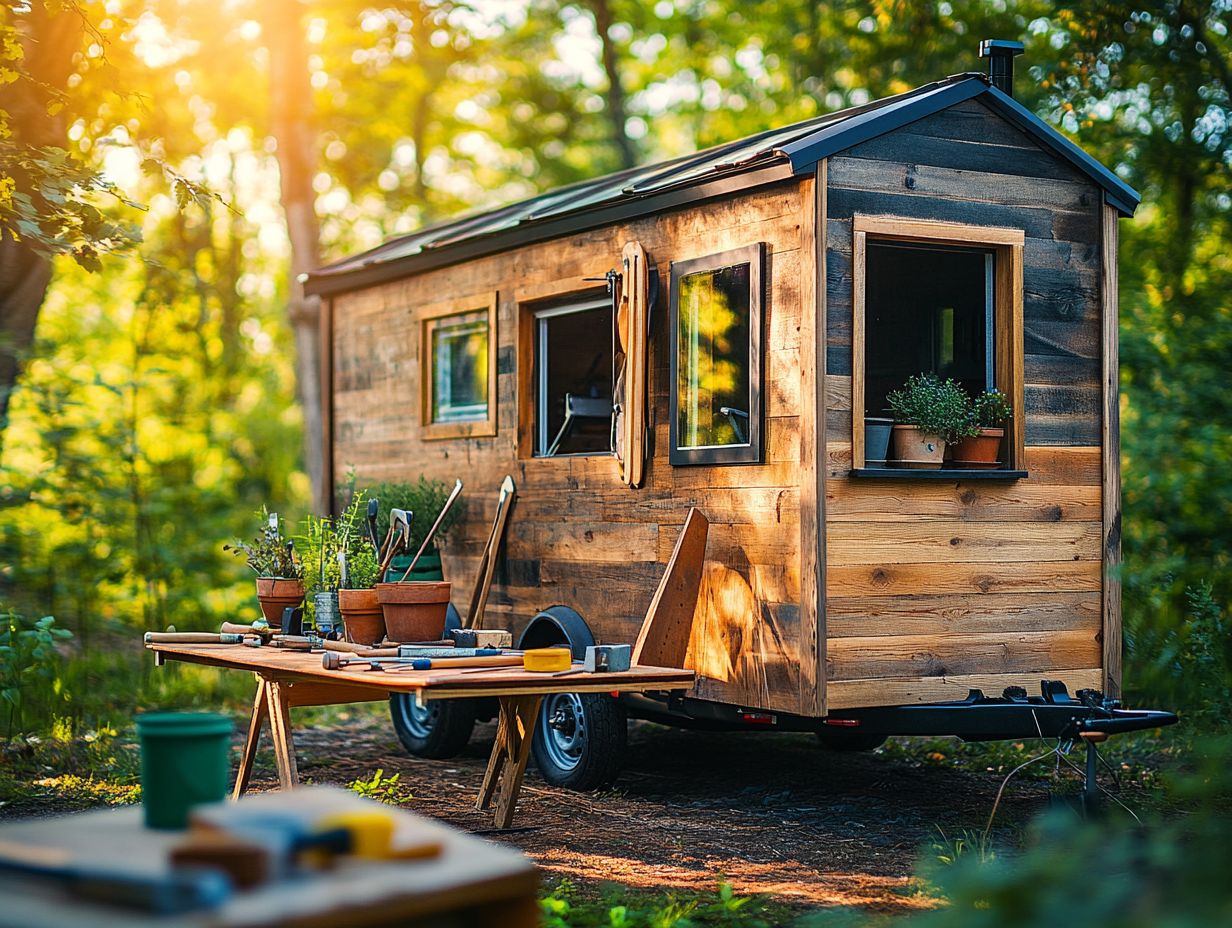
Maintaining the plumbing and electrical systems in your tiny house is crucial. Efficient use of space and resources is vital for both comfort and functionality.
Regular plumbing inspections and HVAC (heating, ventilation, and air conditioning) maintenance boost energy efficiency and help prevent costly repairs.
Over time, sneaky leaks can lead to significant water damage, while outdated electrical wiring could create fire hazards. Regular evaluations allow you to spot common issues like corrosion and wear.
Hiring qualified professionals can save you time and money! Consider installing low-flow fixtures or energy-efficient appliances to conserve resources and save money over time.
Being proactive in these areas is key to preserving a safe, efficient, and comfortable living environment.
5. Clean and Declutter Regularly
Regularly cleaning and decluttering your tiny house is crucial. Making the most of your limited space can significantly elevate your living experience.
Implement effective cleaning tips for upkeep to ensure your space remains both functional and inviting.
Utilizing fold-down furniture helps maximize available area, making every corner count. Embracing DIY methods for organization creates a streamlined tiny house experience.
Incorporate vertical storage solutions, like shelves and hooks, to capitalize on every inch without sacrificing style.
Adopt a minimalistic approach to ensure each item you bring in serves a purpose and adds value to your home.
Regularly revisit storage areas to assess your belongings and prevent clutter from creeping in. This fosters a sense of calm and order.
Ultimately, maintaining a tidy environment enhances the aesthetics of your compact space and promotes mental clarity, reducing stress.
How Often Should Tiny House Maintenance Be Done?
Determining how often you should perform maintenance on your tiny house is crucial for ensuring its long-term durability and functionality, especially when you ve invested in eco-friendly features and efficient systems. Regular upkeep can prevent minor issues from spiraling into costly repairs while enhancing your overall living experience in that compact space.
How often you maintain your house depends on several factors, such as the materials you’ve chosen, the climate where you live, and your personal lifestyle choices.
Given the unique challenges of tiny living, crafting a tailored maintenance schedule that addresses your specific needs is essential. For example, you might want to schedule quarterly checks on your plumbing to look for leaks and ensure optimal insulation. Your electrical systems could benefit from biannual inspections to guarantee safety and efficiency. You should also maintain the exterior, particularly in fluctuating weather conditions, which should include seasonal evaluations to protect against wear and tear. Additionally, considering essential tips for sustainable tiny house design can further enhance your approach to maintenance.
Your individual lifestyle factors, such as mobility and usage patterns, will also influence the maintenance timeline. By incorporating these considerations and exploring 5 ways to make your tiny house more eco-friendly, you can create a more manageable and effective upkeep plan that keeps your tiny house in top shape.
What Are the Most Common Maintenance Issues in Tiny Houses?
Common maintenance issues in tiny houses often arise from the unique challenges of compact living. Plumbing and electrical connections frequently require your attention. Problems such as leaks, inadequate heating or cooling from heating, ventilation, and air conditioning systems, and wear on eco-friendly features can emerge if you overlook regular maintenance. Recognizing these common issues is crucial for preserving the integrity and functionality of your tiny home.
You may find that dampness becomes a concern due to limited ventilation, which can lead to mold growth if not addressed promptly. Make it a priority to regularly inspect the seals around your windows and doors to significantly reduce moisture problems. The compact nature of tiny spaces can also cause flooring and cabinetry to wear out more quickly, making it essential to invest in quality materials and protective treatments. For those considering renovations, following 5 tips for sustainable tiny house renovations can provide valuable insights.
When it comes to electrical issues, using surge protectors and scheduling routine check-ups can help you avoid larger power-related failures. By approaching these maintenance tasks proactively, you can ensure a smoother, more enjoyable tiny living experience, highlighting the importance of timely upkeep.
How Can One Prepare for Seasonal Changes in a Tiny House?
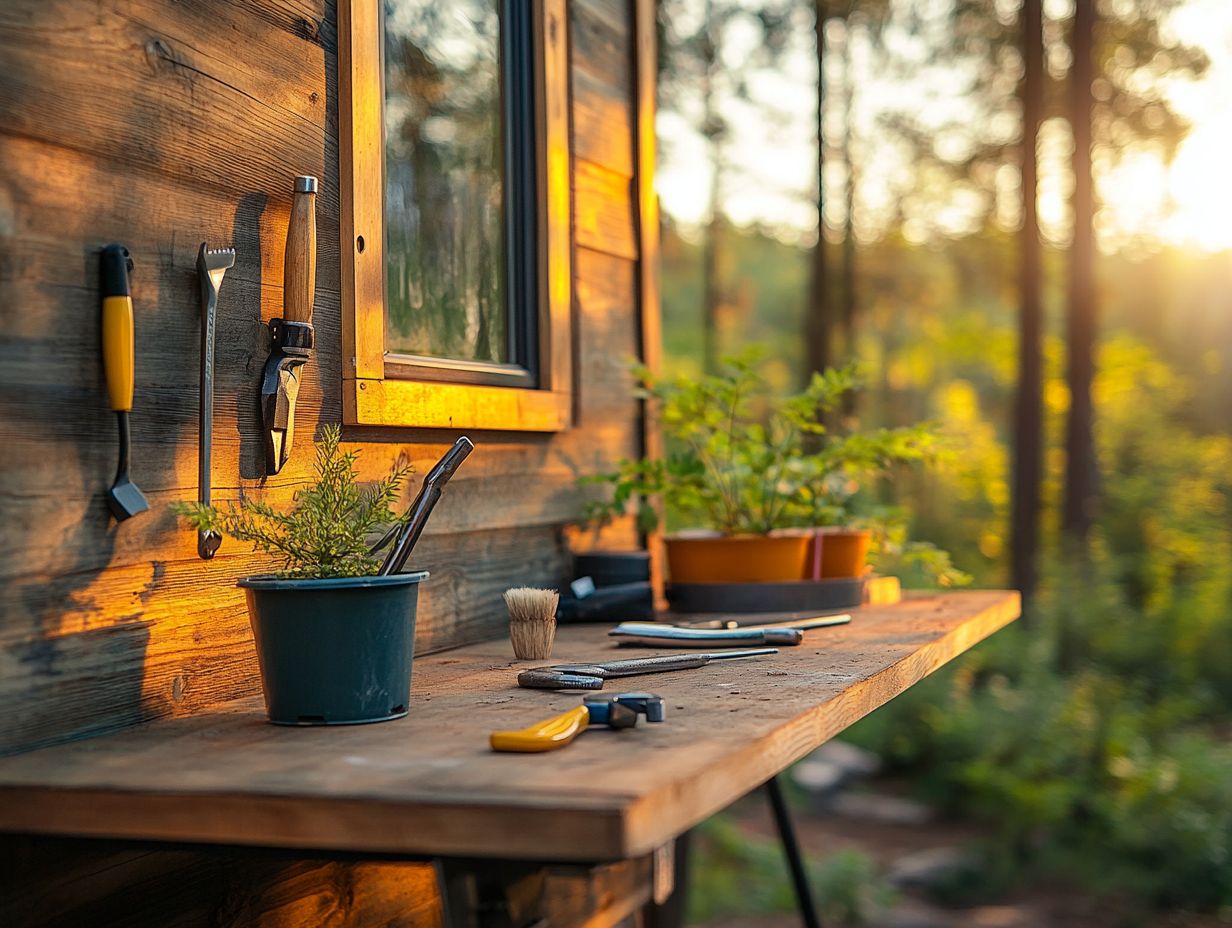
Preparing for seasonal changes in your tiny house is essential for maintaining a comfortable and efficient living environment, especially when considering energy efficiency and home maintenance. Your seasonal tasks might include HVAC maintenance, checking insulation levels, and ensuring that outdoor spaces are ready to face the elements. By taking proactive steps, you can effectively safeguard your tiny home against the weather and enhance your overall comfort.
Understanding the unique challenges that each season brings allows you to implement targeted strategies to optimize your living space. For instance, in winter, it s crucial to insulate windows and doors to keep those pesky drafts at bay. The warmer months might require you to explore sun-shading solutions or adjust ventilation to maintain a cool atmosphere. Make it a priority to inspect your roof for snow accumulation or debris to avoid potential leaks.
Fall is the ideal time to clean gutters and assess your heating systems, ensuring everything functions smoothly when you need it most. By thoughtfully approaching these seasonal transitions, you not only guarantee your comfort but also promote sustainability through lower energy consumption.
What Tools and Supplies Are Needed for DIY Tiny House Maintenance?
Having the right tools and supplies for your DIY maintenance in a tiny house is essential for efficiently managing upkeep tasks and ensuring the longevity of your home. You ll want to gather a basic toolkit, cleaning supplies, and specialized equipment for eco-friendly features like solar panels and compost toilets. Understanding what you need empowers you to tackle maintenance challenges with confidence.
Furthermore, consider the unique challenges of tiny living; your tools should be space-efficient, can do more than one job, and easy to store.
When selecting quality tools, prioritize those made from durable materials and backed by a solid warranty it’ll give you peace of mind for long-term use.
For storage, think vertical. Utilize wall space, magnetic strips for your metal tools, and collapsible organizers to keep everything accessible while minimizing clutter. A well-organized tool area not only saves you time during repairs but also makes your space feel organized.
How Can One Save Money on Tiny House Maintenance?
You can absolutely save money on tiny house maintenance by blending cost-effective strategies with DIY approaches, allowing you to stretch your budget further. Embracing energy-efficient upgrades not only contributes to long-term savings on utility bills but also minimizes the need for frequent repairs. By cultivating proactive maintenance habits, you can significantly reduce costs and enhance your living experience.
Regularly tackling simple household repairs, like fixing leaks or replacing worn weatherstripping, can lead to substantial savings over time. Investing in routine inspections helps you catch minor issues before they snowball into major problems, ultimately safeguarding the integrity of your tiny home. Additionally, considering 5 essential tips for efficient tiny house layouts can optimize your space and enhance functionality.
Exploring local workshops for DIY repair classes empowers you with new skills while fostering a sense of community engagement. Using sustainable materials during upgrades helps streamline your maintenance efforts and create a more resilient dwelling. By integrating these strategies, you position yourself for long-term success and financial flexibility.
What Are the Benefits of Regular Tiny House Maintenance?
Regular maintenance of your tiny house brings a wealth of benefits that enhance both the quality and longevity of your home. By consistently addressing maintenance tasks, you can boost energy efficiency, improve functionality, and prevent costly repairs. Ensuring the safety of your electrical and plumbing systems also leads to a more comfortable living environment. Ultimately, investing in regular upkeep is crucial for maximizing both the value and enjoyment of tiny house living.
For example, when you keep your appliances in top-notch condition, you help maintain optimal energy use, which can significantly lower your utility bills. One tiny house owner even reported a remarkable 30% decrease in energy costs after starting a maintenance schedule.
By regularly inspecting your insulation and sealing any air leaks, you ll enjoy a cozy space, regardless of the weather outside, greatly enhancing your overall living experience. These proactive measures not only support a more sustainable lifestyle but also cultivate a nurturing environment for those who aspire to minimalist living without sacrificing comfort.
Frequently Asked Questions
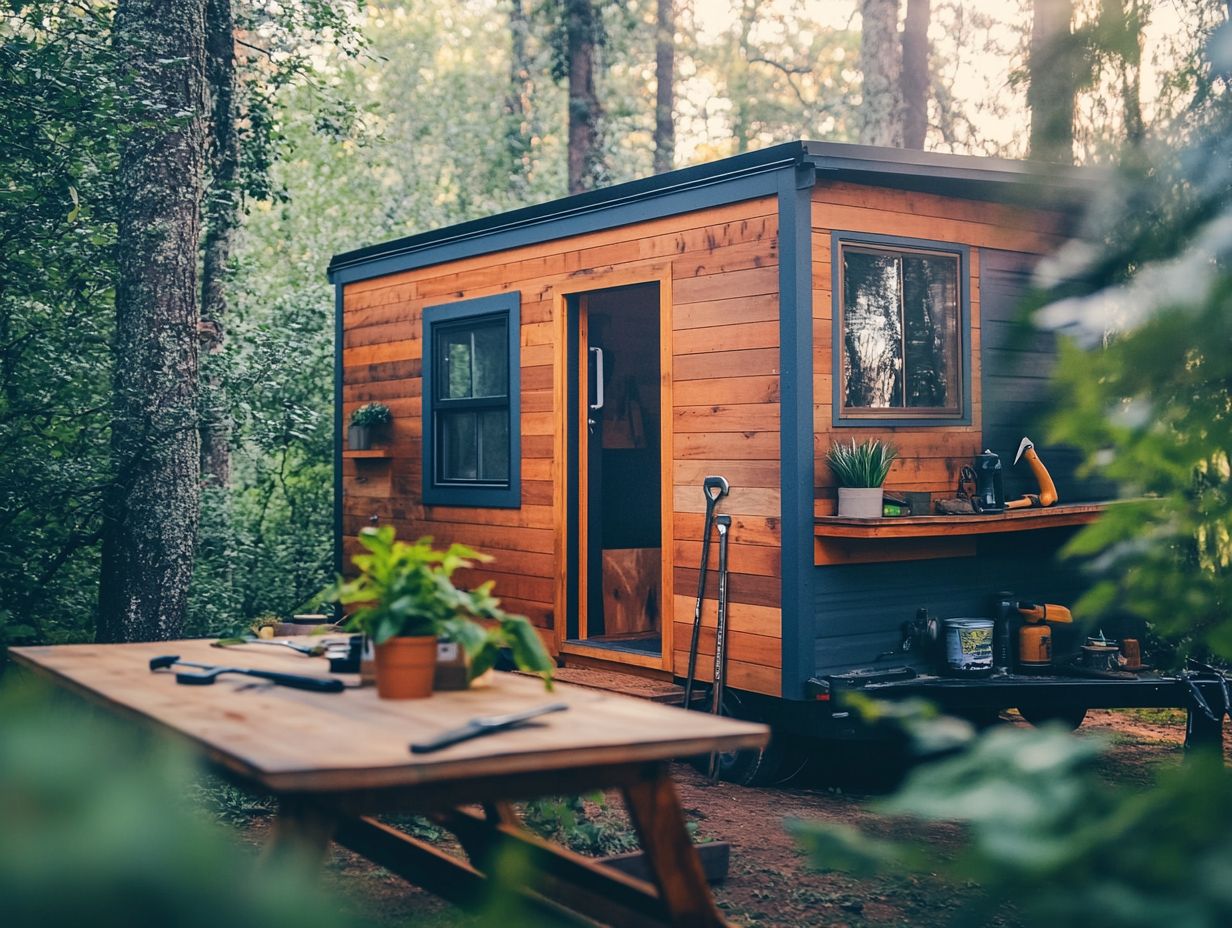
What are 5 DIY Tiny House Maintenance Tips?
- Regularly clean and declutter your tiny house to prevent build-up of dust and debris, which can lead to mold and other issues.
- Check for any cracks or gaps in the exterior walls, roof, and windows and seal them to prevent water damage and drafts.
- Keep an eye on your plumbing system and fix any leaks or clogs immediately to avoid costly repairs down the line.
- Inspect your electrical system regularly and replace any damaged wires or outlets to prevent fire hazards.
- Maintain the foundation of your tiny house by regularly checking for any signs of shifting or settling and addressing any issues promptly.
Start your DIY maintenance journey today! Join a community and share your experiences to enhance your tiny house living.
In summary, regular maintenance is essential for preserving the quality and comfort of your tiny house. By implementing these tips, you can enjoy a more sustainable and fulfilling living experience.
Why is it important to maintain a tiny house?
Maintaining your tiny house is essential for its longevity and your safety. Neglecting upkeep can lead to costly repairs, mold growth, electrical fires, and structural damage.
Can I perform DIY maintenance on my tiny house?
Yes! Many maintenance tasks are easy to do yourself. For complex issues like electrical or plumbing problems, hire a professional to ensure safety.
When should I schedule maintenance for my tiny house?
Schedule regular maintenance every 6 months to a year, depending on your tiny house’s condition and climate. Address any issues immediately to avoid bigger problems.
Are there specific maintenance tasks for a tiny house on wheels?
Yes, check the tires and wheels regularly for wear and tear. Ensure they are properly inflated, and inspect the hitch and trailer frame for damage or rust.
What should I do if I notice a major issue with my tiny house?
If you notice a major issue, like a significant leak or structural damage, consult a professional right away. Ignoring these problems can lead to costly and dangerous consequences.

